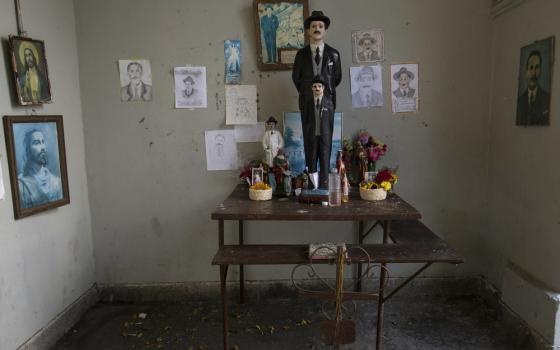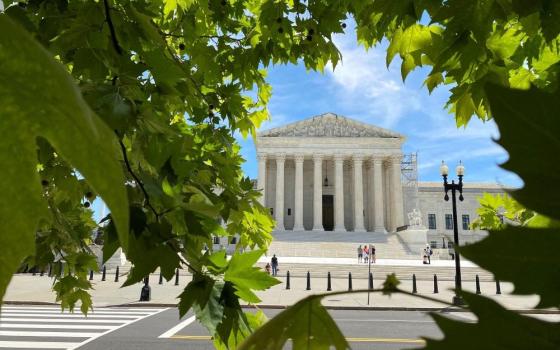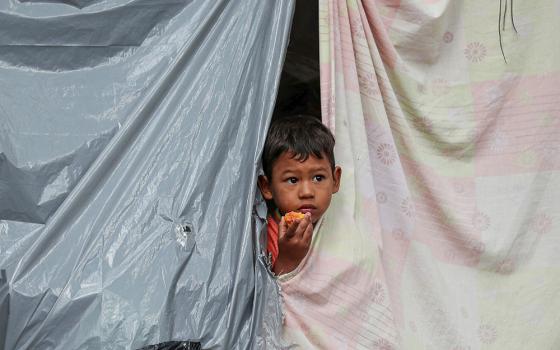Syria's roll call of missing Christians continues to grow.
In April, Islamic militants kidnapped two Orthodox prelates, Syriac Orthodox Archbishop Mar Gregorios Yohanna Ibrahim and Greek Orthodox Archbishop Paul Yazigi. In July, the same fate befell Italian Fr. Paolo Dall'Oglio, a well-known Jesuit pioneer in Christian/Muslim relations and anti-Assad activist. The whereabouts of all three remain obscure.
Given the courage and persistence shown by the country's religious women, it was probably inevitable that sooner or later it would be their turn, and that's precisely what happened this week.
Sometime late Sunday night or early Monday morning, an armed group linked to the rebels forced their way into the storied fourth-century monastery of St. Thecla (Mar Takla) in the village of Maalula, about 35 miles north of Damascus. It's one of those famed ancient Christian villages that still speaks Aramaic, by tradition the language of Christ.
The monastery's mother superior, Sr. Pelagia Sayyaf, and 11 other Orthodox nuns were taken away to the nearby rebel stronghold of Yabrud.
Though some rebel sources insisted that the sisters had been evacuated for their own safety, most observers regard it as a kidnapping, something that's become a sad fact of life for the country's Christian minority. Last February, the website Ora pro Siria, operated by Italian missionaries in Syria, launched an emergency fundraising appeal it called "Ransom a Christian." The website reported that the going price for a kidnapped priest in Syria today is in the neighborhood of $200,000.
The news that the sisters had been taken was confirmed Monday by the papal nuncio in Damascus, Italian Archbishop Mario Zenari. On Wednesday, Pope Francis launched an appeal for their safe return during his general audience.
"I invite you all to pray for the nuns of the Greek Orthodox convent of St. Takla of Maalula in Syria, who were forcibly taken away by armed men two days ago," the pope said. "We pray for these nuns and for all kidnap victims in the conflict."
Though Christians long ago became targets of choice for radical elements within the anti-Assad uprising, this particular act has set off special alarms in part because Mar Takla isn't just any monastery. Along with the nearby monastery of Mar Sarkis, it represents the heart of Syria's antique Christian presence that reaches back to the Roman era. It's still an important point of reference, as Mar Takla was a popular center for the Sept. 7 day of prayer and fasting called by Pope Francis on behalf of peace, widely seen as a gesture of opposition to Western military strikes.
In part, too, Sayyaf isn't just any nun. She's a formidable figure, often willing to speak out about the situation facing Christians amid the country's civil war. She's paid a price for her candor, having been excoriated in turn both by the rebel forces and the Assad regime depending on what she's had to say.
Last March, for example, Sayyaf was blasted by the rebels for an interview she gave to Western media in which she denied that Assad's army was engaging in indiscriminate killing and said that the situation for Christians was markedly better in areas under the regime's control. The opposition was especially incensed that she closed her comments by saying, "God bless Assad."
In September, however, pro-government social media sites labelled Sayyaf a terrorist because of another interview in which she refuted claims from the regime that rebels had assaulted Christians in her area. A pro-Assad Facebook site labelled Sayyaf a "traitor," accused her of being friends with Dall'Oglio (and thus, presumably, hostile to Assad), and suggested that her loyalties to Syria are suspect because she's Lebanese.
Although a friend reported that she spoke to Sayyaf by phone Monday and that Sayyaf said she and the other sisters were safe, it's not clear what their abductors want or how long the women might be held.
The drama is merely the latest chapter in the rapidly deteriorating situation facing Christians in Syria. At the same time the nuns were being taken, militants took over the Armenian Church of the Martyrs in Raqqa, in the country's north, unveiling an Islamic banner atop the church.
In his final speech as president of the U.S. bishops' conference, Cardinal Timothy Dolan of New York recently called his brother bishops to ramp up their efforts on behalf of suffering Christians around the world. Right now, Syria would be a great place to put those words into action, insisting that the Obama administration use whatever nominal influence it may have with the rebels to secure the safe release of Sayyaf and the other sisters.
In early Christian tradition, Thecla was a follower of St. Paul who, as the story goes, was saved from her persecutors by a mountain of Maalula that miraculously opened up to shelter her. Right now, Syria's Christians are probably praying for another such miracle, because they certainly could use one.
* * *
We already knew that Pope Francis has become a media icon, but the events of the last couple of weeks have put an exclamation point on that reality.
First came the astonishing level of interest generated by his apostolic exhortation Evangelii Gaudium, "Joy of the Gospel." I've been covering the Vatican for the better part of 20 years, and I've seen 12 apostolic exhortations come and go during that span, seven under John Paul II and four from Benedict XVI. Popes generally use this literary genre to distill the results of a synod of bishops, and take my word for it: This is the first one to become a global news event.
Believe it or not, this was a rare case in which the American media actually covered a pope story with greater vigor than its Italian counterparts, given that Italy at the time was distracted by the spectacle of Silvio Berlusconi's expulsion from the national senate.
There were, to be sure, a few truly newsworthy elements in "Joy of the Gospel," including Francis' call for bishops' conferences to be given teaching authority and his explicit link between evangelization and the social gospel. For the most part, however, that wasn't what we talked about on air. It was "Francis, the man of the people" and "Francis, the maverick" storylines that had already been well established but that don't seem to have lost any of their charm.
Late last week, another pope story was born and died in almost the same instant.
Polish Archbishop Konrad Krajewski, known universally in Rome as "Don Corrado" and recently named by Francis to head up his personal charitable efforts, sat down for a chat with a few Italian journalists. Krajewski is well known for moving around Rome at night to look after the poor and homeless, and somebody asked him if Francis ever goes along.
His reply was more or less "next question," delivered with a smile, which some read as an indirect confirmation that we're living in the pages of a Morris West novel, with a pope walking around Rome incognito.
A flustered Krajewski called up Corriere della Sera, Italy's paper of record, to set the story straight: "It's not true at all, good grief," he told a reporter. "For sure, the Holy Father would like to [go out], just as he'd like to go out to hear confessions from the faithful, but it's not possible and it's never happened," he said.
The Vatican Press Office also issued a denial, with vice director Fr. Ciro Benedettini saying that "the pope has not gone out at night with the almoner, Konrad Krajewski, nor did [Krajewski] say that he did."
Yet another news flash came from Francis himself during a visit to a Roman parish Sunday. Disregarding his prepared text, as is often his way, Francis took a stroll down memory lane about his youth, telling parishioners he had once worked as a bouncer in Buenos Aires, Argentina. Among other reactions to that tidbit, the "Today" show quickly proclaimed him "the coolest pope ever."
Three points are perhaps worth taking away from this latest round of pope-mania.
First, there's a growing tendency in the Catholic blogosphere to grouse that Francis is becoming more myth than man, that a cluster of urban legends are growing up that threaten to turn the pope into what one Italian blogger recently called "a cartoon strip for kids." The danger, as some of these commentators see it, is that important aspects of the pope's character and message, such as his repeated warnings about the devil and the "spirits of this world," are being obscured.
Of course, there's always a risk of selective emphasis and myth-making when the media decides to turn someone into a celebrity, but I would put the situation this way: Isn't it better that people are paying attention than not?
Surely deciding what to do with a massive global megaphone is a better problem than wondering how to get that megaphone in the first place.
Second, we're probably in for a long run of pope storylines that are going to burst on the world like a spring thunderstorm, and some of them, like his alleged nocturnal outings, are likely to be bunk, rooted in misunderstandings or in breathless leaps to premature conclusions. The old rule of caveat emptor, therefore, will be more critical than ever.
Actually, this dynamic may offer a new lease on life to Catholic journalists everywhere, some of whom are feeling a bit disoriented at the way the general-interest media has sort of ripped the pope story away from them. Insiders no longer may have a monopoly on the beat, but they may be able to rebrand as the go-to destination for rumor control.
Third, there's a sense in which the media ferment amounts to a virtual application of Francis' memorable line from Evangelii Gaudium: "I prefer a church which is bruised, hurting and dirty because it has been out on the streets, rather than a church which is unhealthy from being confined and from clinging to its own security."
By injecting himself so thoroughly into the 21st-century media culture, Francis runs the risk of seeing his image distorted, obscured and occasionally caricatured. From his point of view, however, that's preferable to staying out of the fray -- because the fray, after all, is where real people live.
* * *
By way of a heads-up, Monday brings another watershed moment in the Vatican's ongoing effort to convince the world it's turned over a new page vis-à-vis financial transparency.
Moneyval, the Council of Europe's anti-money-laundering agency, is scheduled to adopt a progress report on the Vatican's transparency campaign, following its first review of the Vatican in July 2012. At that time, evaluators applauded the Vatican for "coming a long way in a short time" but also raised serious questions on two key fronts:
- The need for independent oversight of the Institute for the Works of Religion, better known as the Vatican bank;
- Clarifying the powers and role of the Financial Information Authority (AIF), a watchdog unit created under Benedict XVI.
Francis has moved on both fronts, issuing a recent legal document expanding the powers of AIF to include not just monitoring transactions but also approving anyone who wants to do business in the Vatican, and also creating a commission to study the long-term future of the Vatican bank. When Monday's report is released, we'll know what Europe's team of evaluators makes of those steps.
Perhaps not entirely coincidentally, the Vatican announced Thursday that AIF has signed a memorandum of understanding with Germany's financial intelligence unit, a body known as the Zentralstelle für Verdachtsmeldungen at the Bundeskriminalamt.
That's a normal development for countries that want to show they're playing by the global rules of transparency and follows similar recent agreements between AIF and the financial intelligence units of the United States, Belgium, Italy, Spain, Slovenia and the Netherlands.
"This memorandum is strengthening AIF's international reach and further integrates the Holy See and the Vatican City State with a coordinated global effort to fight money laundering and the financing of terrorism," said René Bruelhart, AIF's director, in a Vatican statement.
"Today's signing underlines our fruitful relationship and will further facilitate our joint efforts," Bruelhart said.
* * *
Pope Francis' kitchen cabinet, the "G-8" council of eight cardinals from around the world, met this week in Rome to kick around some ideas for Vatican reform, apparently reviewing each Vatican department one by one. My colleague Joshua J. McElwee was in Rome covering the story, and readers can find his reports on the NCR website.
[John L. Allen Jr. is NCR senior correspondent. His email address is jallen@ncronline.org. Follow him on Twitter: @JohnLAllenJr.]
Editor's note: We can send you an email alert every time an All Things Catholic column is posted to NCRonline.org. Go to this page and follow directions: Email alert sign-up.



